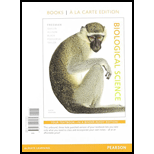
Concept explainers
Introduction:
Species is the term used to describe the group of individuals having similar characteristics and able to reproduce among themselves. Species forms the basic level of the taxonomic hierarchy. Species richness includes the total number of different species found in an ecological region. This particular richness serves as a good measure of the quantification of different species in a typical area.
Answer to Problem 1TYK
Correct answer:
Species richness is generally defined as the number of different species present within an area.
Explanation of Solution
Explanation/justification for the correct answer:
Option (a) is given that the species richness typically measures the number of species found in an area. Species richness takes into account the crude quantitative aspects of the number of species in an area. This richness is specifically concerned with the overall number of different species located in a geographical or ecological construct. Hence, option (a) is correct.
Explanation for incorrect answers:
Option (b) is given that species richness defines the quality of species in the given area. The quality of species in an area is measured through species diversity specifically. Species richness is only concerned with the quantity of the different species. So, it is an incorrect option.
Option (c) is given that the functional importance of a species is measured through species richness. Species richness only provides a quantitative measure of the different members of a species located in an area. However, the functional importance of a species relies on the interaction among the species, which cannot be explained through species richness. So, it is an incorrect option.
Option (d) is given that the species richness measures the abundance of individuals present within a species. The abundance of the individuals within a given species is measured through the study of species abundance or relative species abundance. However, species richness does not take into account these two factors. So, it is an incorrect option.
Hence, options (b), (c), and (d) are incorrect.
Species richness serves as a crude measure of the number of different species present within an area. The measure can only be utilized to get a quantitative picture of the overall species in an ecological community.
Want to see more full solutions like this?
Chapter 54 Solutions
Biological Science, Books a la Carte Plus Mastering Biology with Pearson eText -- Access Card Package (6th Edition)
- In one paragraph show how atoms and they're structure are related to the structure of dna and proteins. Talk about what atoms are. what they're made of, why chemical bonding is important to DNA?arrow_forwardWhat are the structure and properties of atoms and chemical bonds (especially how they relate to DNA and proteins).arrow_forwardThe Sentinel Cell: Nature’s Answer to Cancer?arrow_forward
- Molecular Biology Question You are working to characterize a novel protein in mice. Analysis shows that high levels of the primary transcript that codes for this protein are found in tissue from the brain, muscle, liver, and pancreas. However, an antibody that recognizes the C-terminal portion of the protein indicates that the protein is present in brain, muscle, and liver, but not in the pancreas. What is the most likely explanation for this result?arrow_forwardMolecular Biology Explain/discuss how “slow stop” and “quick/fast stop” mutants wereused to identify different protein involved in DNA replication in E. coli.arrow_forwardMolecular Biology Question A gene that codes for a protein was removed from a eukaryotic cell and inserted into a prokaryotic cell. Although the gene was successfully transcribed and translated, it produced a different protein than it produced in the eukaryotic cell. What is the most likely explanation?arrow_forward
- Molecular Biology LIST three characteristics of origins of replicationarrow_forwardMolecular Biology Question Please help. Thank you For E coli DNA polymerase III, give the structure and function of the b-clamp sub-complex. Describe how the structure of this sub-complex is important for it’s function.arrow_forwardMolecular Biology LIST three characteristics of DNA Polymerasesarrow_forward
 Concepts of BiologyBiologyISBN:9781938168116Author:Samantha Fowler, Rebecca Roush, James WisePublisher:OpenStax College
Concepts of BiologyBiologyISBN:9781938168116Author:Samantha Fowler, Rebecca Roush, James WisePublisher:OpenStax College
 Human Biology (MindTap Course List)BiologyISBN:9781305112100Author:Cecie Starr, Beverly McMillanPublisher:Cengage Learning
Human Biology (MindTap Course List)BiologyISBN:9781305112100Author:Cecie Starr, Beverly McMillanPublisher:Cengage Learning Biology (MindTap Course List)BiologyISBN:9781337392938Author:Eldra Solomon, Charles Martin, Diana W. Martin, Linda R. BergPublisher:Cengage Learning
Biology (MindTap Course List)BiologyISBN:9781337392938Author:Eldra Solomon, Charles Martin, Diana W. Martin, Linda R. BergPublisher:Cengage Learning Biology Today and Tomorrow without Physiology (Mi...BiologyISBN:9781305117396Author:Cecie Starr, Christine Evers, Lisa StarrPublisher:Cengage Learning
Biology Today and Tomorrow without Physiology (Mi...BiologyISBN:9781305117396Author:Cecie Starr, Christine Evers, Lisa StarrPublisher:Cengage Learning





